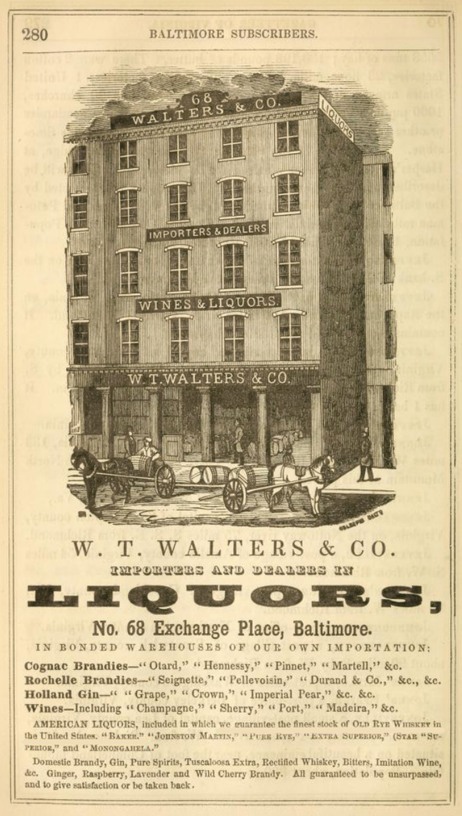So much of Pennsylvania’s distilling history has been lost to time. One glaring example of forgotten history has been Somerset County’s distilleries, once well-known in the whiskey trade for their double-distilled, fire-heated copper pot still, pure rye whiskey.
Perhaps the loss of this information had to do with much of the whiskey produced in Somerset County being sold by an important Maryland liquor firm. It was common practice for distillers to sell wholesale packages of whiskey (by the barrel) to liquor firms, but it was a bit different for Somerset County’s distilleries because one liquor firm acquired the lion’s share of the county’s most productive distilleries. One company gained exclusivity to their collective output. Another possible reason Somerset County’s distilleries were forgotten may have been that the most famous of Somerset County’s distilleries was arguably Buhl & Gatesman, which produced a more traditional PA chamber still rye whiskey. This doesn’t make E. Buhl’s Distillery any less important or impactful, it just differed from the trade norms embraced by the rest of the county since the late 1700s. While Edwin Buhl didn’t fire up his distillery in Meyersdale until 1901, the property had previously belonged to Henry Stahl (since 1894) and had been known as “the old Karn Distillery” before that. While the “Old Karn distillery” may have produced fire-heated, copper pot still whiskey, Buhl & Gatesman had a 2 chamber still and doubler installed in their still house which more closely aligned them with the rest of Western Pennsylvania’s modern rye whiskey producers. But most of the smaller distillers in Somerset County had maintained a reputation for the old traditions…that of double-distilled, direct-fired copper pot still pure rye whiskey.

As I’ve said, this style of fire-heated copper pot still whiskey is not often attributed to Pennsylvanian distillers. The reason behind this confusion is that by the late 1800s, most of the whiskey manufactured in Somerset County’s distilleries was being bottled by Edwin Walters of E. Walters & Co. (previously W.T. Walters & Co.) in Maryland. Edwin Walters had also been owner of the Canton Distillery in Canton, Maryland, which was famous for its “Orient Pure Rye Whiskey.” He had decades of experience selling rye whiskey, and even before buying Somerset County’s distilleries outright, he had established exclusivity rights from the previous owners of those properties. By the 1890s, Walters began purchasing several of his favored distillery sites. He wasn’t the only liquor businessman to invest in Somerset’s distilleries- John Topper was another- but Walters’ business being “out-of-state” was unusual. Pennsylvanians were usually not keen on carpetbaggers, but Walters was unique in that he had spent years building those relationships. The Somerset Herald quoted Edwin in May 1890 as saying:
“Somerset County is unquestionably the purest and best manufactured in the United States, and like the champaign (sic) produced in France, cannot be equaled.”

The common thread which set these distilleries apart was their use of fire-heated copper pot stills to distill their whiskeys during an era when chambered stills and steam heat were the norm. It was also the reason that Walters bottled his various distilleries’ whiskeys under the same label- “Old Baker Rye Whiskey.” Old Baker Rye was considered a Maryland rye, but the whiskey in those bottles was from Somerset County, Pennsylvania.


The “Old Baker Rye” brand had been connected to Henry Baker of Somerset County since the early 1800s and had earned its wide reputation for excellence well before the Civil War. Long before Walters purchased the Baker Distillery property, his firm had been using Henry Baker’s famous name to bottle its sourced whiskey. Once he owned the Baker property, he would rebuild the old plant and name his newly refurbished distillery the Bakersville Distillery. Edwin Walters finished construction of his new “Bakersville Distillery” in the winter of 1892 and production of rye whiskey commenced that February.

Walter’s personal success with his Somerset County distilleries would be short lived, however. Edwin Walters died suddenly and tragically in 1897 in a carriage accident. All the whiskey being stored in Walters’ bonded warehouses was sold through his estate in 1901 to Henry Luyties & Bro., a huge rectifier and liquor firm in New York. The whiskey purchased was sold and shipped to Bremen, Germany for storage. Though the distillery and its whiskey would eventually cease to exist in its original form, the name “Old Baker Whiskey” would forever remain indelible in consumers’ minds as denoting quality and purity.

Old Baker had become a household name and would remain so for a new generation of drinkers after Prohibition. Of course, once the last barrels of Somerset County’s rye whiskey was all bottled and sold, the Old Baker name remained. The Pennsylvania distilleries that made it famous, however, were long gone. Without the PA rye whiskey that made it famous, the brand was sold to Frankfort Distillery Co. and it became a blended whiskey. Today, perhaps unsurprisingly, Old Baker lives on a Canadian whiskey.
Another interesting bit of information- The Guiness Book of World Records recognizes the oldest bottle of whiskey in the world to be a bottle of Baker’s Pure Rye, bottled in 1847. You can read about that HERE.

